Chapter 13 - How Cells Obtain Energy from Food
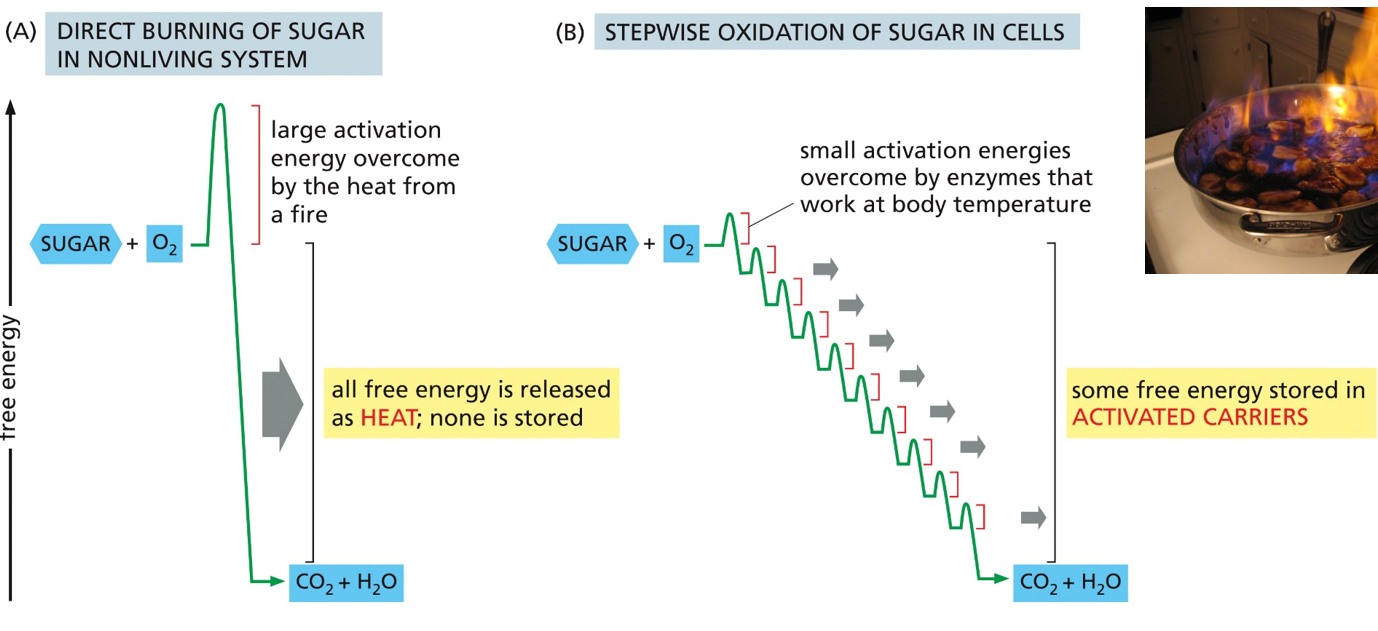
The breakdown of sugar requires lots of energy, all of which is released as heat. Enzymes help reduce the amount of energy this requires, and sugars are oxidated over time and will keep decreasing the energy within the sugar molecule
Hyperglycemia is too much glucose, hypoglycemia is not enough. It is transported into the cell using uniporters
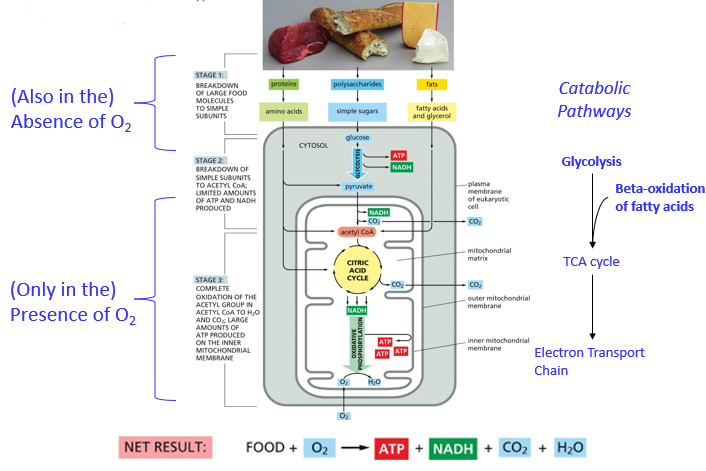
Catabolism has different steps, including glycolysis, beta-oxidation of fatty acids, the TCA cycle, and the electron transport chain (ETC). The overall equation is Food + O2 → ATP + NADH + CO2 + H2O. Without oxygen, glycolysis can only happen. The citric acid cycle uses oxygen. NADH plays a large role, as demonstrated above. Ultimately, oxygen takes up the protons that are created by reactions, with the energy from electrons going to be stored in ATP
Stage 1 is without oxygen, and breaks down large food molecules into smaller subunits (protein → amino acid, polysaccharide → simple sugars, fats → fatty acids/glycerol)
Stage 2 only occurs with oxygen, and breaks down these subunits into acetyl CoA, and produces a limited amount of ATP and NADH
Step 3 is also only done without oxygen, and oxidates the acetyl group from acetyl CoA into CO2 and H2O, which produces large amount of ATP on the inner mitochondrial membrane
Many catabolic pathways intersect, such as carbohydrate metabolism and fatty acid metabolism, along with amino acid metabolism all leading to acetyl CoA
Glycogen is how animals store sugar, it is a large branching molecule with individual units of glucose
A given polymer of glycogen may interact with glycogen phosphorylase, to either add too or remove a glucose molecule. If one is removed, it then goes through glycolysis
Carbohydrate loading will help an athlete store glycogen in the liver. This allows athletes to have energy from its breakdown for longer. Glycogen is the mass storage of glucose, stored in chain-linked molecules. Glycogenin is a protein with 2 binding sites of glucose, which allow for glycogen to form around it
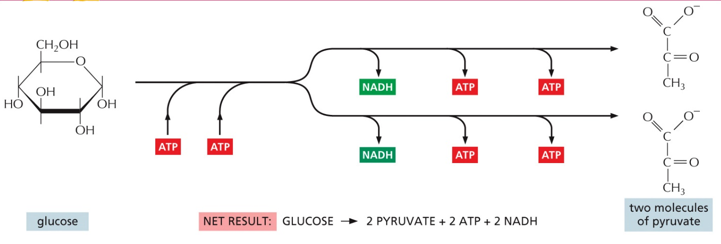
Glycolysis takes glucose and breaks it into pyruvate, ATP, and NADH. The process requires 2 ATP but produces 4 ATP. A kinase phosphorylates a phosphate from ATP to a substrate. Other kinases transfer a phosphate to ADP to form ATP. Isomerase prepares molecules for future chemical alterations. Dehydrogenases generate NADH (signal a redox reaction or electron transfer), and mutases move the phosphate to help prepare the substrate to transfer the group to ADP to produce ATP
This process will happen with or without oxygen. It will use ATP, but also produce ATP
In the cytosol, glucose is broken down into 2 pyruvate, and is then transported into the mitochondria against its gradient with the use of a symporter. From here, it is broken down into AcetylCoA
Fatty acids are directly transported into the cell and through the cytoplasm into the mitochondria, where they are broken into AcetylCoA
Each amino acid may have a different break down process, due to the unique side-chains. They funnel into various catabolic pathways
Energy is transferred back to ATP via oxidative phosphorylation (in mitochondrion with oxygen) or substrate level phosphorylation (no oxygen, other molecules have lower delta G and transfer the phosphate)
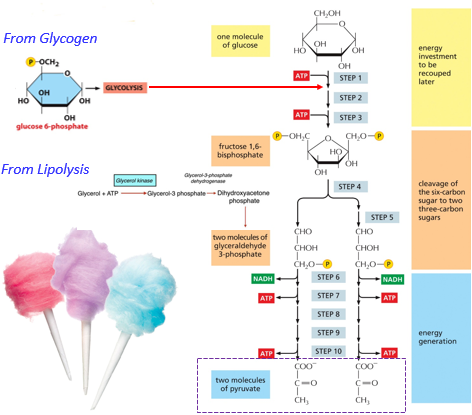
Another way to go into glycolysis is when glycogen goes straight into step 2, saving the ATP used in step 1. Lipolysis also has early entry, going straight into step 6
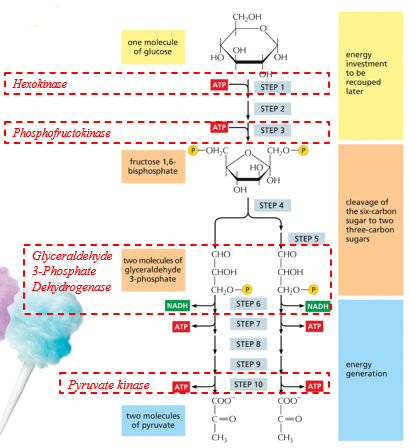
Generally in glycolysis, phosphofructokinase regulates it and initiates the steps of breaking down the sugar requiring the 2 ATP. Eventually, 2 ATP, 2 NADH, and 2 pyruvate are produced. Beginning group uses ATP, and end steps produce ATP. Step 6 is important without oxygen, the NADH is used in fermentation.
Steps of Glycolysis (don’t need to know specifics, only biological purposes for 1,3,10):
Glucose is phosphorylated by ATP to form a sugar phosphate, the negative charge traps it in the cell. This step is irreversible, generally removes glucose from the concentration membrane, keeping glucose concentration low intracellularly. This is however not a committed step to glycolysis, the process can still divert. The result, glucose-6-phosphate, can go into glycolysis, or it can go back into glycogen if there is excess ATP (what happens during carb loading). It can also go into the pentose phosphate pathway and produce NADPH. This makes it a metabolic linker.

?
A new hydroxyl group in C1 is phosphorylated by ATP, to prepare for the formation of two 3 carbon sugar phosphates. This step regulates the entry of sugars into glycolysis, via phosphofructokinase. This is the first dedicated step between glycolysis and pyruvate.

?
?
(7) The oxidation of an aldehyde to a carboxylic acid releases energy, much of which is captured and carried by ATP and NADH. Forms a high energy intermediate, which can be done in the absence of oxygen which is important for fermentation. Overall forms 1,3-bisphosphoglycerate (1,3-BPG). This is specifically formed through substrate level phosphorylation. The first ATP is formed in step 7, there is a substrate that is an intermediate
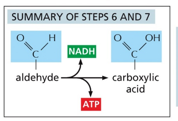
?
(10) A high energy intermediate is formed, allowing for it to be done without oxygen

A high energy phosphate group is transferred to ADP, forming ATP and completing glycolysis. This substrate level phosphorylation allows for ATP production in the absence of oxygen. This requires 31 kg/mol of energy (delta G) so the phosphoryl transfer is made to be high potential, and want to transfer the phosphate energetically. -62 plus 30 is overall favorable

The high energy bonds broken to form ATP typically come from anhydrides, either anhydrides using carbon or other phosphates (like in ATP)
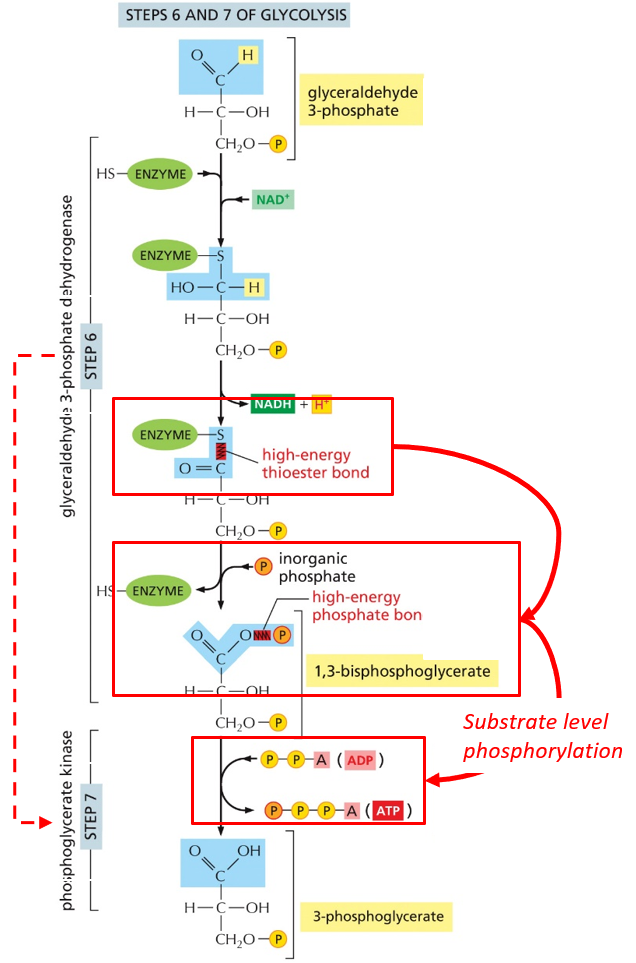
The key step in 6 is the formation of 1,3-bisphosphoglycerate (1,3-BPG), a high energy intermediate used in substrate level phosphorylation to eventually form the first ATP in step 7. This entire process is happening twice, as a glucose ring is split into two and undergoes the process for each half. This is all happening in the cytosol

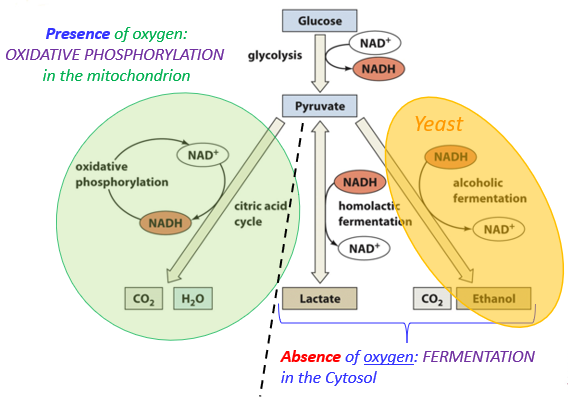
In the presence of oxygen (aerobic), oxidative phosphorylation is done in the mitochondrion. Without oxygen (anabolic), fermentation is done in the cytosol. Pyruvate is a metabolic linker, and can go into these multiple pathways. There are multiple kinds of fermentation, yeast produce alcohol and humans produce lactate. NADH is by far the most important electron carrier in this process. With oxygen, NAD+ → NADH and without oxygen NADH → NAD+
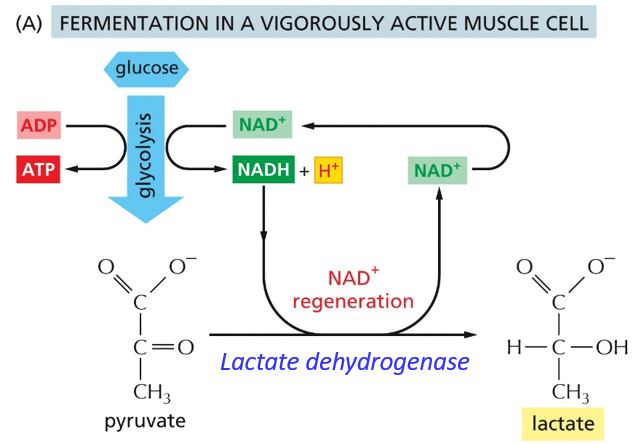
Fermentation only occurs without the presence of oxygen. In yeast, there is an additional step. This happens in muscle cells, glycolysis is extended by one redox reaction, pyruvate is reduced to lactate by NADH, NADH is oxidized to NAD+. This allows for it to go back into step 6 of glycolysis and keep powering anaerobic respiration. Yeast has an addition decarboxylation step, and reduces pyruvate into ethanol. It also yields NAD+, which goes back into step 6 of glycolysis
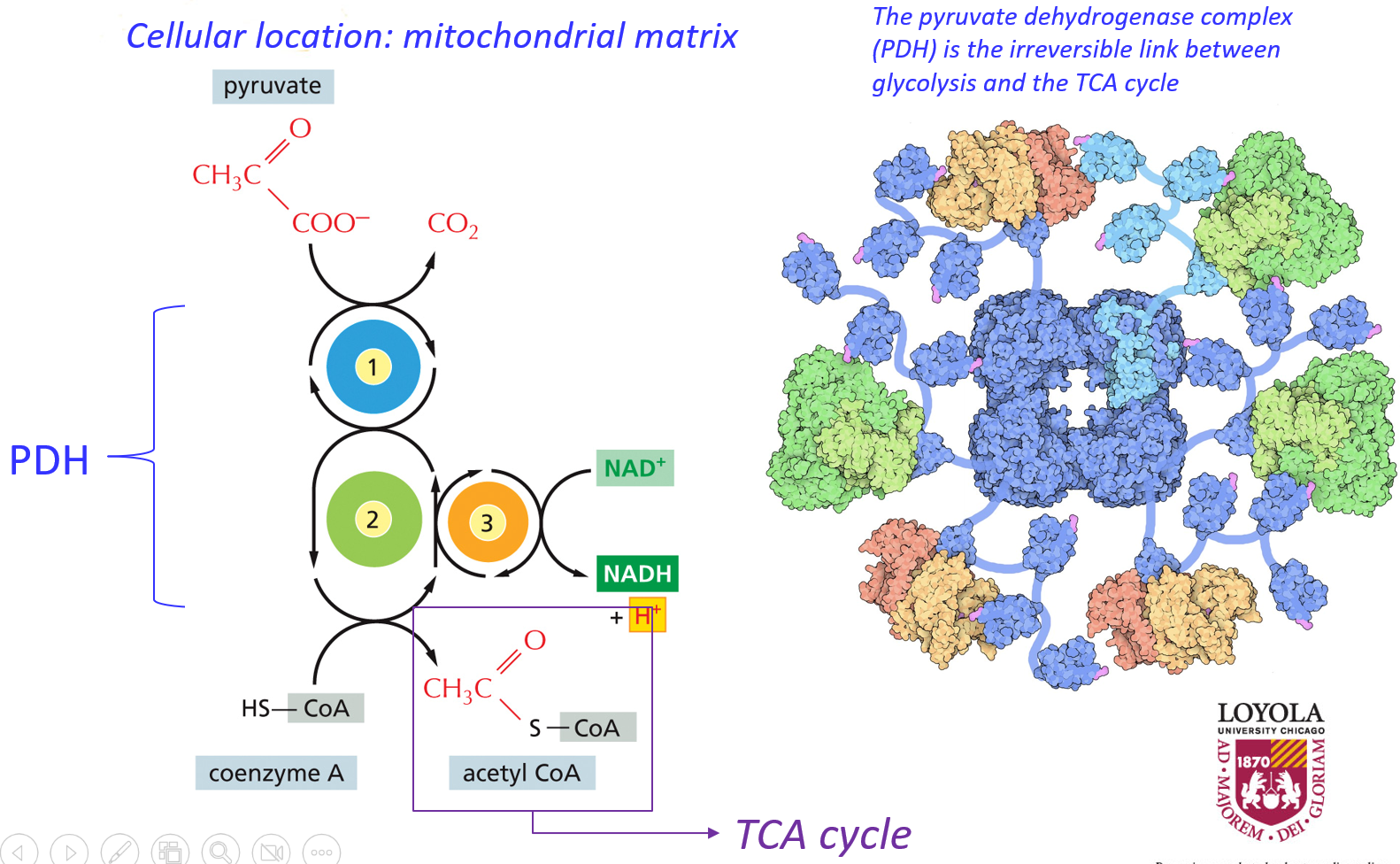
Pyruvate dehydrogenase complex (PDH) is located within the mitochondrial matrix, and is the irreversible link between glycolysis and the TCA cycle (Kreb’s Cycle). This is in the mitochondrial matrix
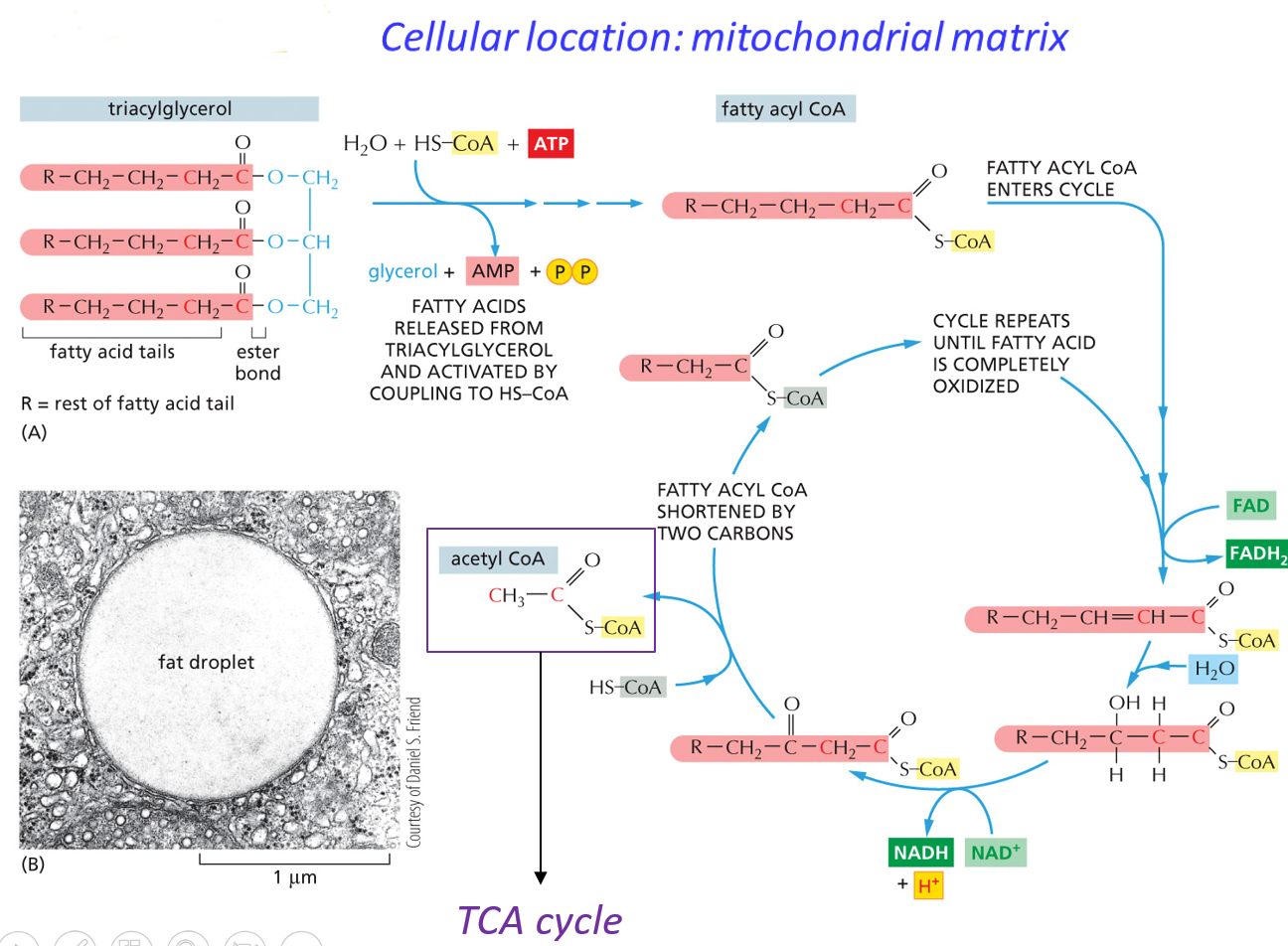
Beta oxidation is the step that converts fatty acids into acetyl-groups, and is done in the mitochondrial matrix with the presence of oxygen. Lipases are enzymes that hydrolyze the fatty acids from a triacylglycerol. In this process, each carbon tail is chopped into 2s, each of which can become a acetyl group. It is cyclic and keeps repeating this process.
Acetyl groups produced by beta oxidation and PDH are transported by CoA into the Kreb’s Cycle, CoA isn’t being produced by these processes. CoA is recycled and reused to carry more acetyl groups.
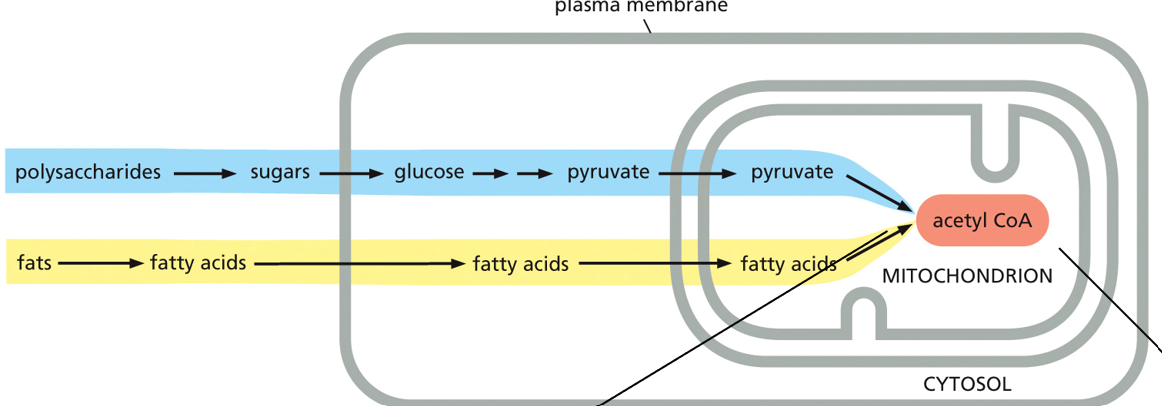
Acetyl CoA production from sugar and fat follow this, where they are then funneled into the Kreb’s Cycle. CoA ends in a sulfur, and is an ATP derivative. The sulfur allows for high energy thiol bonds to be formed with an acetyl group. CoA is like ATP, but with only 2 phosphates and a long hydrocarbon tail with the sulfur.

The TCA cycle is the central catabolic pathways in the cell. Also called citric acid or Kreb’s cycle. Acetyl CoA is funneled in, reacts with oxaloacetate with 4 carbons. They come together to form citric acid. Part 1 is the harvesting stage, from steps 1-5. Overall the 6 C goes down to 4 C (released as CO2) and transfers electrons to NADH. Step 5 onward regenerates the acetyl group to go through the cycle again. This is known as Reconstitution of Oxaloacetate. Each sugar must go through this cycle for each acetyl group it has (coming from total carbons/2, i.e. 16 carbon sugar results in 8 acetyl groups). Overall, produces 1 GTP/ATP, 1 FADH2, 2 Co2, and 3 NADH.
Muscle cells go straight to ATP rather than GTP, most other cells go to GTP. In the lungs GTP is produced and transformed into ATP almost immediately.
The electrons of FADH2 are transferred to CoQ (Ubiquinone) through the electron transport chain (ETC). CoQ is a carrier within the ETC.
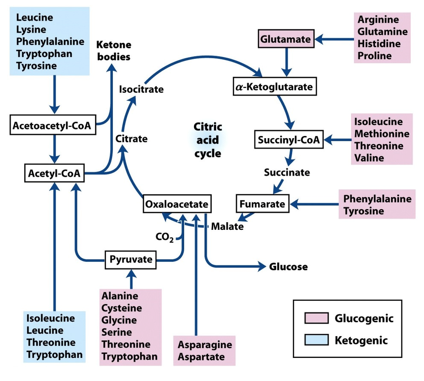
Amino acid degeneration and anaplerotic reactions can be glucogenic or ketogenic. They enter at multiple sites due to unique side chains.
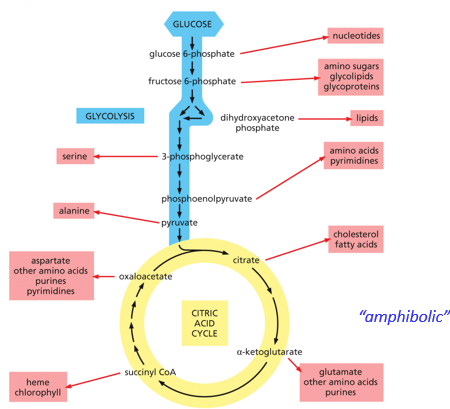
Catabolic pathways provide building blocks for the cell, after breaking them down from macromolecules. The process is amphibolic, as it has catabolic and anabolic characteristics. The energy is transferred through the catabolic reactions, but the remaining products can also be used.
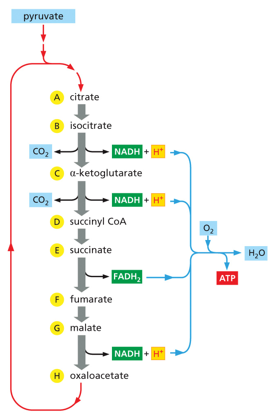

Oxidative phosphorylation releases CO2 and consumes O2. Memorize and learn this figure. Kanzok loves it. Two membranes surround the mitochondrial matrix. All of the above processes occur here. Pyruvate enters, and goes through PDH to make Acetyl CoA and into the Kreb’s Cycle to turn NAD+ into NADH, which happens to release 2 electrons and oxygen. Electrons go into proton pumps in the ETC to form a proton gradient which is used to turn ADP into ATP through reverse pumps via ATP synthesis. At the end, these electrons are transported onto oxygen and form water with protons in the final redox reaction. Oxygen itself isn’t used in the Kreb’s cycle, but it is used in the ETC that follows the Kreb’s cycle.